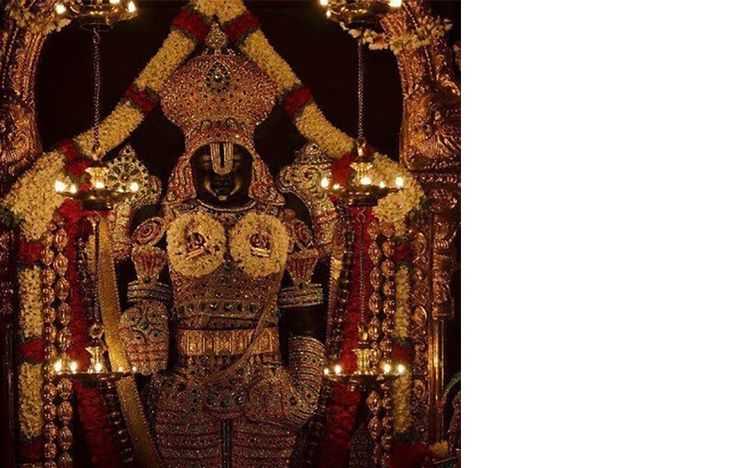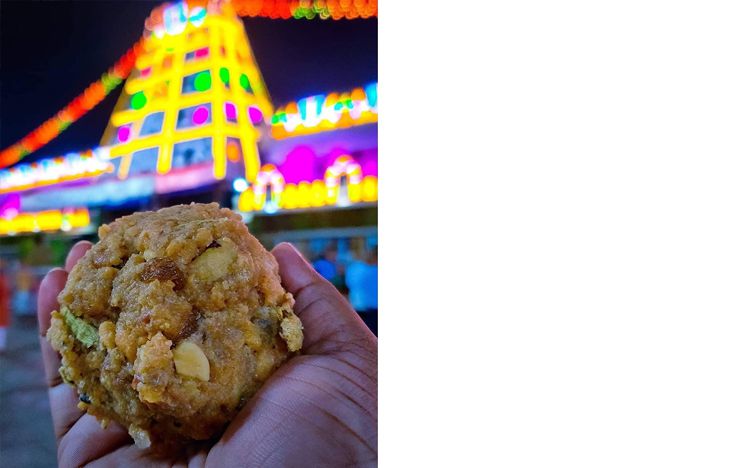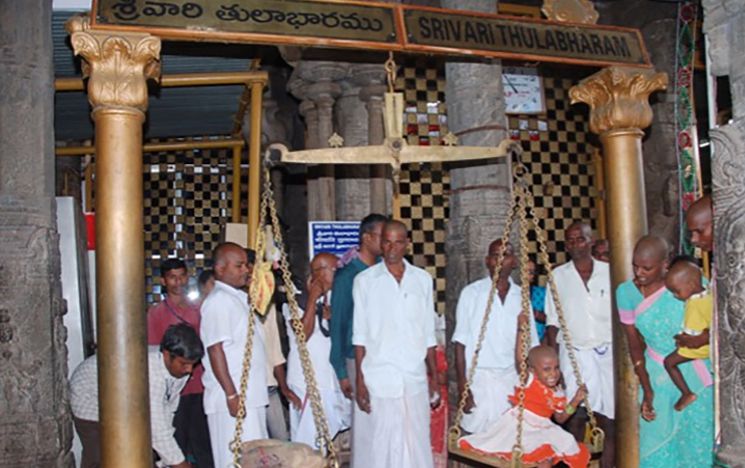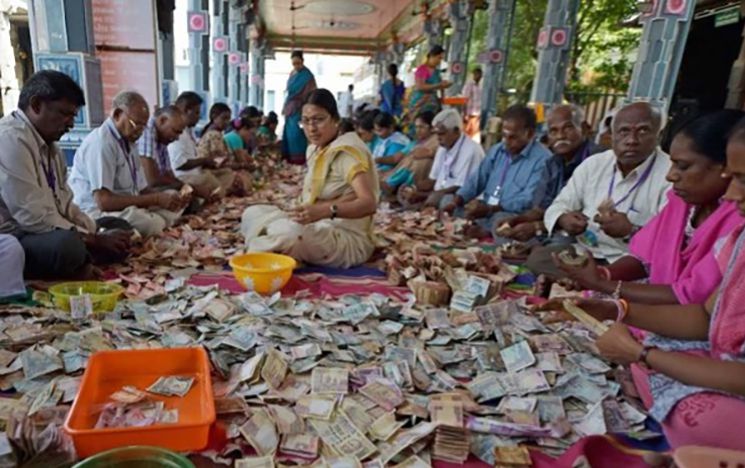Circuits Of Exchange, Donations, And The Holy Deity
Smytta Yadav
"திருப்பதி திருமொழி திருப்பதி திருவிழி"
(Tirupathi Thirumozhi Tirupathi Thiruvizhi)
This saying emphasizes the sacredness and divine significance of the Tirupathi Temple in south India. The Sri Venkateswara deity, also known as Lord Venkateswara or Balaji, holds a significant place in Hindu mythology and is revered as one of the most prominent and beloved forms of Lord Vishnu. As the presiding deity of the Sri Venkateswara Temple in Tirupathi, he is considered the Kaliyuga Varada, the benevolent lord of the current age.
The sculpture is depicted in standing form with four arms. In his upper right hand, he holds the divine discus (Sudarshana Chakra), which symbolizes the power to eliminate evil and protect his devotees. In his upper left hand, he carries the divine conch (Panchajanya), representing the creation and preservation of the universe. The lower right hand is in the abhaya mudra, assuring protection and fearlessness to his devotees, while the lower left hand is placed on his hip in the katyavalambita pose, portraying his grace and magnificence. The deity is adorned with resplendent jewellery, including a crown (kirita mukuta) embellished with gems and jewels, and a garland of flowers that enhances his divine aura. His lotus-shaped eyes exude compassion and serenity, captivating the hearts of his devotees. 
Figure 1: The deity
Pilgrims believe that seeking darshan (act of seeing the divine) of Lord Venkateswara at the temple is a deeply sacred and spiritually uplifting experience. It is believed that the deity's eyes hold the power to cleanse one's sins and grant blessings. The act of witnessing the divine form of Lord Venkateswara is seen as an opportunity for spiritual purification and the fulfilment of desires.
The deity's significance goes beyond his iconic form. Devotees revere him as the ‘Lord of Seven Hills’ (Sapthagiri) as the temple is situated atop the seven hills of Tirumala. The association with these hills and the natural surroundings adds to the divine aura of Lord Venkateswara, making the pilgrimage to the temple even more spiritually significant. The sacred Tirumala Hill, where the Sri Venkateswara Temple is located, is approximately 22 kilometres away from the city of Tirupathi in the Indian state of Andhra Pradesh. It takes about 30 to 45 minutes by road to reach the temple from Tirupathi city, depending on the mode of transportation and traffic conditions. Many pilgrims prefer to travel by buses or private vehicles to make their way up to the Tirumala Hill and seek the darshan of Lord Venkateswara at the temple.

Figure 2: Stairs to the temple site.
The devotion and reverence towards the deity are not limited to a specific region or community but transcend geographical boundaries. Devotees from all walks of life and from different parts of the world including from UK, flock to the Sri Venkateswara Temple, seeking his divine grace and blessings.
In Hindu tradition, the deity is believed to be an embodiment of compassion and love, readily accessible to his devotees' prayers and devotion. His presence is considered a source of solace, inspiration, and spiritual upliftment for millions, fostering a deep sense of connection with the divine and reinforcing the bond between the devotee and the deity. The temple is believed to be one of the most ancient and holiest pilgrimage sites in Hinduism, attracting millions of devotees each year. For many, the journey to the temple is not just a physical one but a spiritual and emotional pilgrimage filled with devotion and dedication.
Devotees embark on the arduous trek to the temple, climbing the seven hills of Tirumala, as an act of penance and to seek blessings from Lord Venkateswara. The act of climbing the hills is seen as a metaphor for overcoming the challenges and struggles of life to attain spiritual liberation and divine grace. It is believed that the journey to the temple purifies the soul and cleanses one of sins, bringing them closer to the divine.
Once inside the temple, the atmosphere is filled with an aura of divinity and devotion. The sacred chants of Vedic hymns, the fragrance of incense, and the ringing of temple bells create a spiritually charged ambiance.
One of the unique aspects of the temple is the laddu prasadam, a sweet offering made to Lord Venkateswara and then distributed to the devotees. It is considered a sacred food blessed by the deity and is believed to bring prosperity and good fortune to those who consume it. The laddu prasadam is highly sought after and is considered a cherished memento of the pilgrimage.

Figure 3: Ladoos
Circuits of Exchange
In the context of economies of pilgrimages, two distinct practices come to the fore within the sphere of the Tirupati Balaji temple: tonsuring and Tulabharam.
The act of shaving one's head is another sacred aspect of visiting the temple. Devotees offer their hair as a symbol of surrendering one's ego and worldly attachments to the divine. This act of sacrifice is seen as a gesture of humility and devotion, symbolizing the devotee's complete surrender to the will of Lord Venkateswara. It is akin to offering a part of themselves to the temple, representing a personal dedication. The temple staff collects the hair and subsequently sells it, utilizing the proceeds to facilitate positive endeavours benefiting all visitors.

Figure 4: Hair donation
Tulabharam represents another facet of engagement. Pilgrims offer items of value such as gold or coins equivalent to their own body weight. This act serves as a tangible demonstration of the pilgrim's profound attachment to the temple. These offerings find a place within the temple's treasury, contributing to its maintenance and supporting various charitable initiatives.
 Figure 5: Tulambaram
Figure 5: Tulambaram
Money (Hundi) Counting
The process of counting money at the Tirupati Balaji temple serves several important purposes. Firstly, it ensures transparency and accountability in the handling of donations. By accurately counting and recording the money received, the temple can provide clear information about how much money has been contributed by devotees and how it is being used for various temple activities and community initiatives. This transparency builds trust among the devotees and ensures that their donations are being put to good use.
 Figure 6: Counting Money
Figure 6: Counting Money
Secondly, accurate money counting helps with proper financial management. The temple has various expenses, such as maintenance, repairs, and supporting charitable projects. By knowing exactly how much money is available, the temple can allocate funds appropriately and ensure that there is enough to cover its various needs and commitments.
Lastly, precise counting demonstrates the temple's commitment to responsible stewardship. The temple is considered a sacred place, and the offerings made by devotees are considered sacred as well. By treating these offerings with respect and accurately accounting for them, the temple upholds its responsibility to use the funds in a way that benefits both the temple and the community it serves. Such principles of transparency, financial management, and responsible administration contribute to the temple's mission and to regulate the everyday temple management and a smooth flow of the pilgrims.